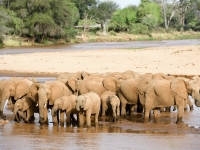 Where to Stay While Visiting Samburu:
Where to Stay While Visiting Samburu:
Larsens Camp | Samburu Intrepids | Samburu Lodge | Samburu Serena
Samburu game reserve is essentially lava plain that features steep sided gullies and rounded hills wherein the 32-kilometre Uaso Nyiro River provides both the central feature of the landscape and the lifeblood of the ecosystem.
The vegetation comprises predominantly acacia woodland interspersed with bush, grass and scrubland, which is broken here and there by small rugged hills whilst the meandering loops of the river are bordered by a narrow gallery of riverine woodland in which acacia and doum palm flourish.
This is a dry country ecosystem and is, therefore, prone to large variations in the animal populations as they move in search of water and pasture. And, whilst poaching has completely wiped out the rhino herds, lion are often seen while the burgeoning elephant herds are responsible for the ruination of several sections of riverside forests. The range of rare species also includes reticulated giraffe, Grevy's zebra, Somali ostrich and gerenuk whilst the bird life is diverse and prolific and includes marshal eagle, pygmy falcons, hornbills and Egyptian geese.
The Samburu people
The Samburu are herders of Camels and Goats, and are often seen on the reserve boundaries bringing their animals to water. Closely related to the Maasai and speaking the same language it seems that when the Maasai migrated to the area from Sudan, some headed east and became the Samburu. Often strikingly tall and slender, swathed in brilliant red cloth 'Shukas', hung about with beads and metal jewellery, the young men (Moran) favour long, plaited, ochre-daubed hairstyles and have a formidable reputation for glamour, prowess and ferocity.
Traditionally the Samburu live off the milk and blood of their beloved cattle and believe that all the world's cattle are theirs by God-given right. Their nomadic and pastoral lifestyle, though historically based on the pursuit of migratory wildlife, is slowly changing thanks to a combination of education, favorable new laws, projects, jobs and income.
Climate
The coast is always hot with an average daytime temperature of 27-31 degrees centigrade whilst the average daytime temperature in Nairobi is 21-26 degrees centigrade. Temperatures elsewhere depend on altitude. July to August marks the Kenyan winter. Broadly speaking, January-February is dry. March-May is wet. June-September is dry. October-December is wet, the rains passing in time for Christmas.
Animals/Attractions
In the arid North of Kenya, water means life. The waters of the great Ewaso Nyiro river draw wildlife in great numbers to its banks, creating an oasis of green. This river flows through three great northern reserves, Samburu, Buffalo Springs and Shaba. This is spectacular country, set against a backdrop of the mighty Mountain Ol Olokwe. The verdant riverine forest is a stark contrast to the arid thorn studded plains. Samburu is visited by large herds of Elephants, drawn by the promise of water. In the dry season, the elephants use their tusks to dig deep into the dry river beds, unearthing precious water. These waterholes then become a focal point for other game.
The Samburu region is the best place to find several endemic Northern species, including Gerenuk, the Reticulated Giraffe, and Grevy's Zebra.
The forests along the river banks are home to many birds, including local species such as the Palm Nut Vulture and the Vinaceous Dove. These forests are also home to many Leopards, often seen at dusk. The sight of one of these beautiful and elusive creatures is always a rare treat.
Lions are also frequently seen on the riverbanks, and Cheetah can be found on the open plains.




